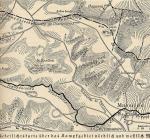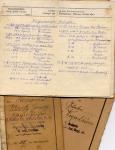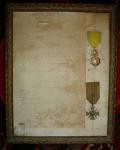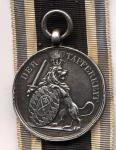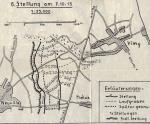-
Posts
29,251 -
Joined
-
Last visited
-
Days Won
84
Content Type
Profiles
Forums
Blogs
Gallery
Events
Store
Everything posted by Chris Boonzaier
-
1) H?he 185 was in the 3. Armee operational area. The heights lie between Tahure and Massiges with the ?Maisons de Champagne? farm on its eastern slopes. At the beginning of 1917 it was decided, for reasons of tactical necessity, to incorporate the heights into the German line. The task was given to General Balck's 51. Reserve Division and would result in numerous local but extremely bloody actions. On the 15th of February the Reserve Infanterie Regiment's 235, 236 and 240, supported by artillery and Minenwerfer fire, managed to take the heights and the farm, forcing their way into French territory along a length of 2.5 km. Suffering minimal losses themselves, the Germans managed to take 800 prisoners. The French retaliated by bringing up extra artillery and pounding the new German positions. On the 8th of March they attacked and a furious fight developed with wave after wave of the attackers being beaten back. In the following days however, the French artillery fire forced the Germans to abandon the farm and most of the peak. The tactical importance of the heights was so great that the German high command immediately ordered the 51. R.D. to retake the lost ground and a counter attack was planned for the 27th of March. A feint was carried out in the neighboring sector by the Infanterie Regiment's 143 and 99. The 51. R.D. assault troops under Oberstleutnant Freiherr von Edelsheim then stormed forward taking the trenches on the heights and continuing down the south eastern slopes. They did not succeed in capturing the ?Maisons de Champagne? farm which stayed in French hands. The units involved in this attack were: Two battalions of the R.I.R. 234, parts of the R.I.R. 236 and R.I.R. 240 and a group of pioneers. 4 officers and 268 French soldiers were taken prisoner. On the 30th of March the French counter attacks resumed. The I./R.I.R. 234 although reduced to 140 men managed to hold her section of the line against a number of powerful attacks, throwing back those French soldiers who had managed to break through with series of counter attacks. In some of the other sectors however the French got a foothold in the German trenches. That evening a counter attack by the divisional assault troops and the Sturmbataillon of the 3. Armee cleared the trenches again. The battle, in churned up positions fought in howling rain and snow, added a page of glory to the 51. R.D.s history.
-
The devil on the mountain - the battle for Height 185 The battle for H?he 185 was a bloody struggle that took place on a divisional level and not being part of one of the major battles of the war means that it invariably slips through the cracks when history books are written. The 51. R.D. of the 26. R.K. had already gained a name for itself during the famed "Slaughter of the innocents" in 1914, in the mud of Langemark and then at Combles on the Somme in 1916. The Height 185 is a less well known, but hardly less dramatic page in the history of the division. A good overview of the battle is presented here along with a gripping and graphic account of the fighting by a German infantryman. 1) An introduction to the Battle for H?he 185 (Maisons de Champagne) loosely based on an account published in "Der Weltkampf um Ehre und Recht" 2) German Army H.Q. announces the first day success in daily orders. 3) Emil Pouplier of the Reserve Infanterie Regiement 234 describes the fighting on the heights as seen by an infantryman.
-
I started doing a bit of research about bertrix when I got the first EK2 doc. It was a nice "complete battle in a nutshell" affair. Then igot the EK2 and 1 to the Hauptman. About a week ago while on EBAY I saw a Milit?rpass and Soldbuch with a EUR20 buy it now. no details about any of the entries.... so i thought... why not... go for it. It arrived today and I was happy to see the tie in for the battle. What is interesting.... the Milit?rpass guy must have been to the north of the forest (entry is "Ochamps" while the Leutnant must have been to the south (Entry on the doc is "Bertrix")
-
To the south the German artillery had exited the forest and had set up on the open ground leading to Bertrix. Eight batteries of field artillery and four batteries of field howitzers watched in excitement as the first retreating battalion of French artillery appeared on the opposite hill. The initial German firing was ragged but the sheer volume was enough to send the remnants of the battalion galloping, trying to reach safety. While the next battalion tried to avoid the skyline they were not able to manoeuvre their guns through the bogs and fences on the other side of the hill. At the end of the day the French division had managed to save only nine of its initial thirty six field guns. As the Germans began rounding up the stragglers the French reserves arrived on the scene. Issued with confusing orders and advancing through the remains of the two destroyed battalions of their field artillery the five battalions of French infantry prepared to counter attack. Facing them were seven and a half German infantry battalions, six batteries of field guns, two batteries of light field howitzers and four batteries of heavy field howitzers. The German artillery was set up as if part of a textbook battle scenario. The field guns were in the front firing line, the light howitzers a few hundred meters behind them and the heavies a thousand meters behind the light howitzers. The French attack ran into a wall of shells and quite naturally crumbled, the Poilus retreating in disarray. It was the last disaster of an already catastrophic day. The French 33. I.D. had been destroyed and only the fact that the Germans did not realise the extent of their victory prevented them from chasing down and destroying the remnants of the French regiments.
-
Meanwhile to the right, on another road through the forest which ran at a 45 degree angle to the advancing French and coming out of the forest at Bertrix, the bulk of the German 21. I.D. was advancing southwards. There were nine battalions of infantry, nine batteries of field artillery and four batteries of heavy howitzers. They came out of the forest at Bertrix just as the last French guns were disappearing into it a few hundred meters away. Shots were exchanged between the German vanguard and the French rearguard with the French keeping the upper hand and advancing towards the German infantry. The German commander, Generalleutnant von Oven ordered two battalions forward to counterattack at which they did at once. Movement was hampered as they were fired on not only by the French infantry spread out along the road into the forest but also by an independent battery of French field artillery far of to the rear which had seen the fighting break out. The forward most German artillery battalion received seemingly suicidal orders to advance and without hesitating they rushed out of the forest, taking up positions on both sides of the road. All the while taking losses, the eighteen guns managed to set up and ready themselves for action. Fortunately for the Germans, the French infantry and artillery had been firing too high and many of their artillery shells had been duds. One of the German batteries faced the rear and took on the independent French battery which was about 5 kms from the point where they had exited the forest. The other two batteries opened fire on the French infantry and the three or four field guns which had been at the tail end of the column entering the forest. At a range of 400 m's the twelve German field guns made short work of the infantry and their handful of field guns as well as a handful of brave French soldiers who rushed out of the forest in an effort to recuperate the guns. The French battery to the rear seemed to loose interest in the fighting at Bertrix and adjusted its fire elsewhere. To the north the French troops were stuck at the exit of the forest at Ochamps, to the south six battalions of German infantry and a battalion of field guns were blocking the southern exit towards Bertrix... and still the Germans did not realise the potential. Von Oven was rather worried about the ten batteries of his artillery still in the forest and fearing a French assault he ordered his men to counterattack. The manoeuvre was simple, 3000 infantryman did a simple right turn and advanced into the forest to meet a French attack that had never been launched. The right wing of the German attack ran into the French troops trapped to the south of Ochamps while those on the left wing ran into the rear elements of the French artillery column. The artillerymen defended themselves bravely with rifles and fists but were no match for the infantry. Soon the rear battalion was overrun. The two artillery battalions in the middle of the forest had but one way out of the mess. A trail turning left off the road had been spotted, a trail that led westwards out of the forest. The order was given for the two battalions to retreat down this trail, out of the forest then over hill 471 and to safety, which they proceeded to do.
-
The Battle at Bertrix... The main body of the French 33rd Infantry Division was advancing northwards from Bertrix through the Forest of de Luchy. They were heading towards the village of Ochamps intending to continue into the open ground beyond. The marching column had four battalions of infantry at the head. Following them were thirty six of the divisions 75mm field guns which were protected by two more battalions of infantry. Orders not to take the guns into the forest had been issued at the last minute but arrived too late to stop them advancing towards a disaster. To the north the unsuspecting French troops marched out of the forest towards Ochamps and soon realised that a strong German force occupied the town as a field battery opened fire on them. The direct fire of the battery was deadly and casualties multiplied as a second, then third battery opened fire on the French troops. In spite of the fire the French infantry advanced and managed to push some of the German forward posts aside but their advance was hampered by wire farm fences and the fact that they could not strike back at the German field artillery which was 1400 meters away. On the left flank things went slightly better for a French battalion. Out of site of the Germans they managed to advance along a gully to the south western corner of the village. Here they ran into three battalions of the German 87. Infanterie Regiment who were positioned there along with their machine gun company. The Germans were able to stop the attack but men from two other French battalions arrived to continue the assault. The commander of the German field artillery battalion ordered two batteries to limber up and sent them rushing down to the front line where they turned their field guns to face the advancing enemy and fired into the advancing French infantryman at point blank range. Four battalions of French infantry were being decimated while their three battalions of artillery lay immobile, stuck on the forest road.
-
EUR30 worth of medals that are worth their weight in gold for me as I know just wher, when and why they were awarded.
-
-
Private Henri Chetou of the 335rd Infantry Regiment died on the Aisne in August 1915. He was awarded the Croix de Guerre and as was customary for men killed in action, he was also entitled to the Medaille Militaire. His citation reads: "Private Henri Chetou While moving forward to relieve a listening post he heard suspicious noises about 100 meters in front of the barbed wire. On his own initiative he made his way forward to investigate and was killed with a bullet to the head at the moment he gave the alarm. Signed: Lt. Col., commanding the 335eme R.I." As both the Germans and the French were actively patrolling it is probable that Chetou ran into a German night patrol.
-

Soviet A dairymaid's medals
Chris Boonzaier replied to Ed_Haynes's topic in USSR: Soviet Orders, Medals & Decorations
Do we get to see the udders ? -
For me a group like this where you can find the exact deed, and/or put the group in its historical perspective makes the items priceless. If someone were to say to me that a mint medal is better I would laugh in their face. Thie? got EUR850 for an uncased one this week... with the history behind this one... I would probably not sell it for double that.... :-)
-
"The French attacked at 17:00 on the 11th of October 1915 to the West of Vimy. After an extremely heavy artillery bombardment twenty French soldiers occupied a crater from a heavy shell that had torn a hole in the German front line to the South of the Artillery trench. Acting independently of his own section Unteroffizier Herrling rushed forward with hand grenades to within 5m of the occupied shellhole while the neighbouring sections which had suffered heavy losses during the artillery preperation began to waver in the face of the attack. Heavy infantry fire caused Herrling to break of a flanking attempt and he instead attacked directly from the trench exchanging hand Grenades with the Frenchmen until his supply of bombs ran out. He then began to use his rifle until he saw the French in the crater signalling to their front line for reinforcements. Hastily collecting some more grenades he attacked the shell hole with such fury that the shattered occupants surrendered soon after." The action as described in the citation is dramatic but the reality was probably even more so. After the terrible bombardment an adrenaline charged Herrling must have been a fear evoking sight indeed. The suffering of the Poilus must have been immense as the grenades detonated within the confines of the shell hole, the blast and splinters having a more or less captive audience. Had they not stayed put and had they done a leap forward they would probably have suceeded in overpowering and probably killing Herrling. As it is, luck was on Herrlings side that day.
-
"Time passed slowly for the Regimental staff on front of Vimy. The telephone lines had been destroyed early in the afternoon and from 3 pm onwards there was no communication. Oberst Policza wathched with a heavy heart as the enemy turned our frontline into a crater landscape of mud fountains. Would a single man live through the drumfire? He knew he could rely on the men of the 12th. By 7 pm the telephone connection was functioning. The message came back that not a meter of ground had been lost and that astonishingly the II. batln had suffered only 28 dead and 49 wounded. The III. Batln in the second line at la Folie had only 4 dead and 29 wounded." The French offensive had been stopped but the men of the 12. bay. I.R. were to spend a terrible winter in the rain filled trenches of the Artois. When they were relieved after seven months of bitter positional warfare they expected a well deserved rest, but less than 24 hours later they were on their way to participate in the slaughter at Verdun.
-
On the 10th of September the II. Batln was in the front line when the French attacked: "At 3 pm a group of French soldiers appear in front of the Elsterweg behind a smokescreen. They advance but the attack is broken up under our fire. At 6 pm the enemy has concentrated his fire on our position at la Folie and fires a salvo into his own trenches to get his infantry moving. On the II. Batln. positions gas grenades explode and opposite the 7. Komp the enemy starts to climb out of his trench. Our men are already in positions and shoot them down as the clamber out. Opposite the 8. Komp. the bayonets and helmets can be seen in the front line but Z?gf?hrer Mayerlen calls in artillery fire and the planned attack is not launched. At 6.30 pm the fire dies down although the heavy calibers continue. The positions have suffered badly, the carefully dug positions have collapsed. Every man realised what awaited us the next day and they worked tirelessly to prepare the positions. On the morning of the 11th of October the enemy artillery fire gets heavier and heavier. The large shells come howling over, including 28cm mines. The French have cleared away their defensive barriers, they are going to attack. Our sentries lay tensely behind their steel shields while fountains or earth, mud and smoke go up around them. In the trenches the soldiers are constantly digging out their comrades as the trenches collapse. They try and redig the trenches during the barrage but it is useless. In front of the 6. Komp a 28 cm mine blows a large hole in the trench and this makes movement impossible. The enemy is just 20 meters away and shoot down anyone trying to move along the trench.. Still the attack does not come. At 1 pm the 5. Komp. sees bayonet points in the opposing trenches but the Frenchmen are just removing a sandbag barrier. At 5 pm the French fire moved backwards to the La Folie farm. The moment of relief has come and the men man the firestep. In front of the 5. Komp about 80 Frenchmen are advancing. The few Poilu that are not killed or wounded scramble back to their trench." All along the II. Batln. line the attackers were mown down with accurate rifle and machine gun fire and the French attack crumbles. In a number of places the French occupied shellcraters, a few brave German soldiers were decorated for clearing out these pockets on the 11th of October. (Part of the II. Batln trench....)
-
The Western Front in 1915: The French army had taken over most offensive operations as the British needed time to restructure and train their new Army. In late September the Allies launched three offensives, known as the Battles of Champagne, Second Artois and Loos, the latter being a British "affair". For the Germans the Artois battle was known as the "Autumn Battle at la Bassee and Arras" The 2. bayerische Division had moved from their positions to the west of Peronne to take up position to the west of Vimy on the 7th of October. The 12. bay. Infanterie Regiment was to the Northeast of Neuville in the Prinz Reuss Stellung. They had missed the main part of the battle, the slaughter of late September, but were in position to face the next French attack. From the 7th to the 10th of october they were under heavy artillery and Minenwerfer fire. In some sectors the French infantry were only 30m's away and as a result the men in the front line were also under rifle grenade fire. Life in the front line consisted of waiting for the enemy attack, praying that no shell would land on you... and when it got dark, trying to rebuild some of the defensive positions.
-
The 2nd Artois is a battle about which little has been written. Douglas Porch says "The Battle of the Marne in 1914 and Verdun in 1916, both of which produced a profusion of accounts, seem to fit the stereotypes of glorious victory or heroic sacrifice better than what amounted to the pointless butchery of the Artois. Those who survived tended to keep silent about their experiances. It was a battle that, in military terms, achieved nothing-and yet produced unintended consequences. If nothing else, it must be counted as the prototypical trench slaughter of the great war." The French were to loose an estimated 150 000 men in the Autumn of 1915.



